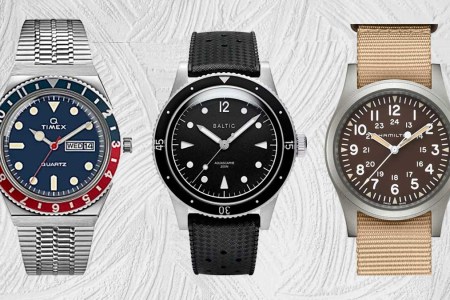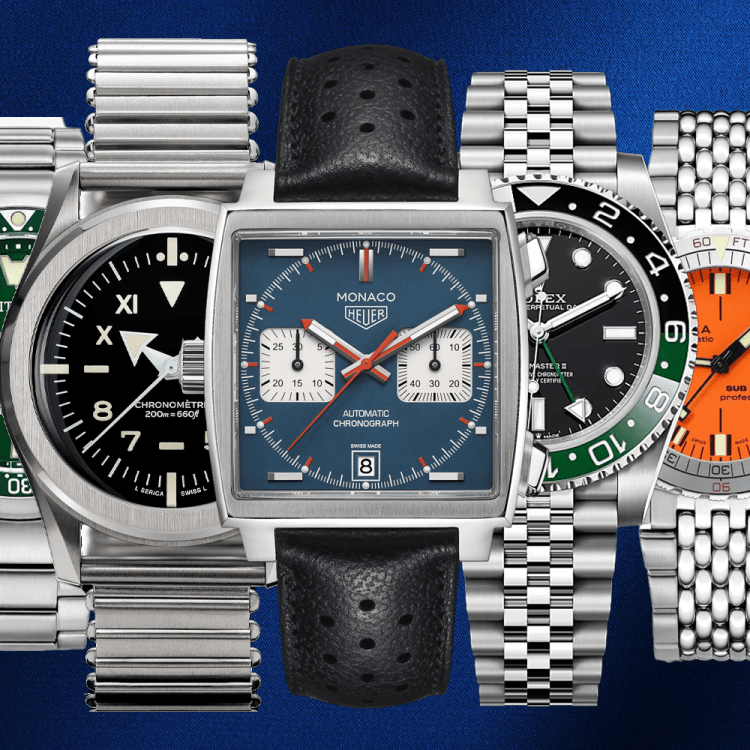There was something in the air back in 2018.
If you’ve been a watch nerd — ahem, an enthusiast — since then, you’ll remember the seminal launch of Hamilton’s Khaki Field Mechanical. Measuring 38mm in diameter, based upon the brand’s vintage mil-spec field watches, powered by a hand-wound movement and costing less than $500, it rewrote the playbook on what a contemporary, utilitarian and affordable watch could look like. As undeniably attractive as all the nascent microbrands and their wares were, here was an enormous, well-established company — a member of the powerful Swatch Group — laying down the gauntlet. It was suddenly clear that the big brands could offer a watch at the intersection of mechanics and affordability that serious collectors could rally behind, and that was cool. Like, really cool.
The good news is that nothing much has changed with respect to the beloved “KFM,” as it’s become known in the watch space: It’s still part of Hamilton’s catalog, and it now comes in more materials, colors and iterations than you can shake a stick at. (You can even get one in bronze, which is kinda rad.) The even better news, for those who still prefer the undeniable convenience of battery operation, is that Hamilton is expanding the Khaki Field collection with a brand new model: The Khaki Field Quartz. Available in both 33mm and 38mm sizes, it maintains most of what we know and love about the KFM, but switches out the hand-wound caliber for a quartz alternative.
The dial, however, isn’t a dead-ringer for that of the KFM: Rather than base it on vintage models issued to U.S. forces during the Vietnam War, Hamilton chose to honor a different watch from its archives: The “G.S.” (General Service) ref. 75003-3 is a nifty 36mm, hand-wound field watch dating to the 1960s that was issued to non-military personnel in the British government. (A largely identical watch, the ref. 6B-9101000-H was issued to military personnel in fairly limited numbers and looks mostly the same, but features the pheon, or “broad arrow” symbol denoting Crown property.)
The 10 Best Watches Under $1,000
Think there are no great watches for less than a grand? Think again.Its railroad minute track, Arabic indices, triangular 12 o’clock marker and lumed sword handset have all been reproduced — though rather than only offering the dial in black, Hamilton has produced four different versions in each of the two size runs: A white dial with blacked hands and “old radium”-colored Super-LumiNova; a blue dial with white hands and white SuperLumiNova; a black dial with white hands and green-glowing SuperLumiNova; and a black dial with white hands and “old radium”-colored Super-LumiNova. While the white- and black-dialed models ship on an olive-green NATO strap with brown leather keepers, the blue-dial version has a matching blue NATO, and the black version a matching black NATO.
Whether you spring for the 33mm version — presumably aimed at a female audience, but perfectly wearable by a man who prefers a smaller watch case — or the larger 38mm size, you still get 50m of water resistance; a non-reflective, brushed stainless steel case; a sapphire crystal; and an excellent price: Both sizes retail for just $395, putting them squarely in gifting territory for the recent high school or college graduate. (Or perhaps “impulse buy” territory for the dedicated collector looking for a relatively inexpensive, unobtrusive travel/adventure watch?)
Watch nerds will invariably ask themselves why the Khaki Field Quartz was necessary: Even after six years of wild economic fluctuations, the price for the base KFM model has increased to just $595, meaning it’s still a wild bargain in the realm of tough, no-nonsense, vintage-inspired mechanical watches. However, we geeks must remind ourselves that most normal people — i.e. non-horo-geeks — have roughly zero desire to spend even 30 seconds hand-winding their watch each morning. Indeed, most young buyers — presumably a significant target audience for many Hamilton watches given their limited purchasing power and the brand’s beautiful affordability — likely have no concept of a hand-wound watch in the first place. Replacing the hand-wound guts of the KFM with a battery-powered movement is thus both sensical and prudent, especially at this price.
Because while die-hard “watch guys” might still prefer the KFM for roughly $200 more, the rest of the world will no doubt find strong appeal in the sub-$400 KFQ. And who says there isn’t room in the horological universe for both?
This article was featured in the InsideHook newsletter. Sign up now.
























